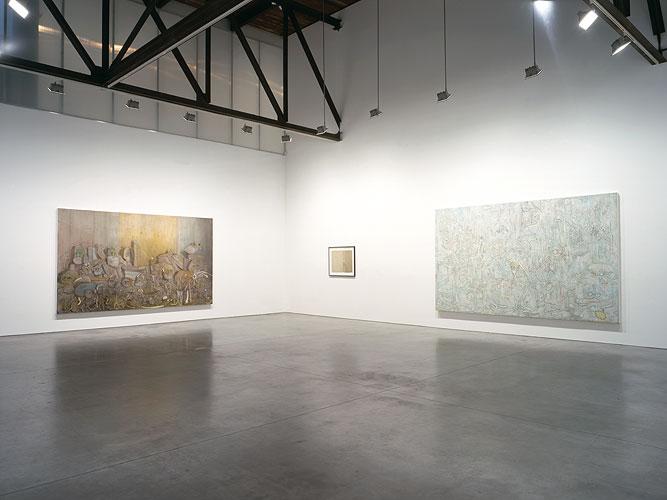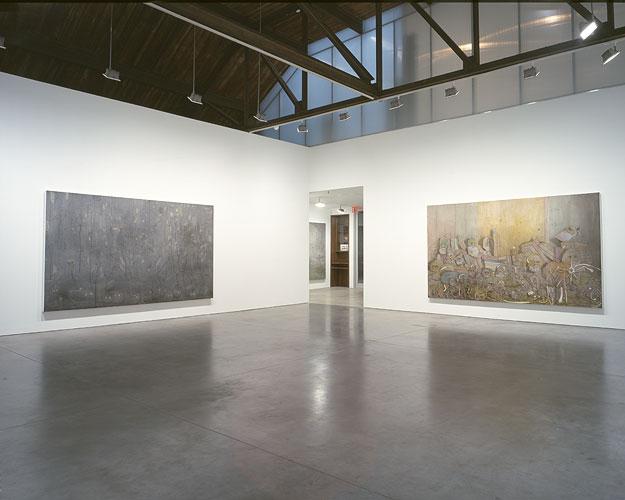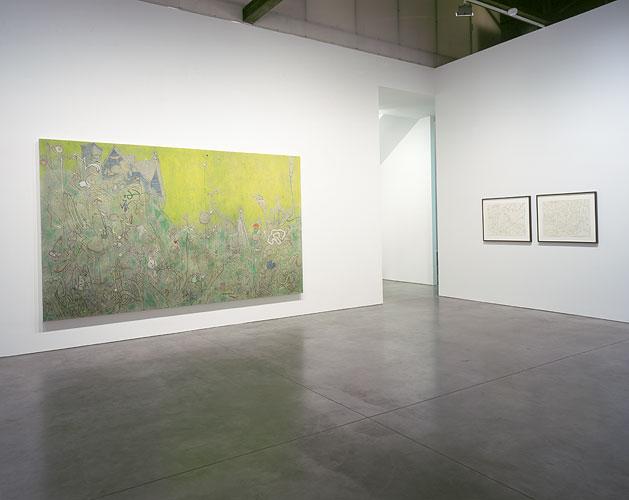Nigel Cooke
"Dead Painter"
November 10 – December 9, 2006
Main Gallery
One of the most brilliant young painters working today, Nigel Cooke's talent is informed by serious intellectual enquiry into his medium and an uncommon fluency in writing about the theory and practice of painting. He has enjoyed a meteoric rise to acclaim over the last five years with an instantly recognizable style and subject matter. How exciting it is, then, to see him evolve without hesitation even beyond the devices that have brought him success, and to track his powerful maturing as an artist in this radical new body of work.
In titling his show 'Dead Painter', Cooke signals both the spirit of irreverence that informs the new work, and its fundamental subject: the role of the painter and the act of painting, which spans the greatest masterpiece and the crudest daubings. He mockingly reserves a place for himself in the pantheon of imposing, bearded "Ghosts That Need Tending", while reducing the great men to melancholy turnip-heads, and so the paintings embody both the vaunting ambition and the destructive self-doubt of the artist. The ambivalence extends into the very language of the paint, which appears in places as gobs of base matter and elsewhere as the element of luminous, transcendent illusion.
Cooke's earlier paintings, shockingly beautiful depictions of a diseased, post-apocalyptic world, had in common a very distinctive pictorial space created by the devices of a low horizon, with a shallow foreground crowded by a blank, oppressive wall. Crude and unintelligible graffiti tags scrawled on the walls or rubble in these landscapes evolved into larger representations (of fruit, skulls, brains, pumpkins, books), at once banal, idiotic and threatening - as if an independent agency operating in that world was making increasingly insistent efforts at communication. In this new body of work it is as if the graffiti has finally subsumed the other elements of the painting, so that foreground and background collapse into one another, laws of perspective and gravity are overturned, and the clamorous, anarchic voice dominates. Yet the greater the load of information, the harder it seems to achieve communication or meaning - as if the very overabundance of information debases its value.
The paintings portray a drama of creative, ordering forces versus chaotic, destructive urges, which is acted out in the process of making itself. The infinitely laborious care which Cooke previously lavished on creating microscopic detail, is here instead squandered on the successive layers which go into constructing each work. Beneath each finished painting many others are interred, as it is painted and overpainted, scoured back and rebuilt: teeming images of which only fragments survive, washes of neon color that persist only as a ghostly glow. Although the paintings have the seeming fluency and spontaneity of the graffiti idiom, their surfaces are pitted and polished like an old plaster wall, apparently aged and weathered. Cooke projects and traces scraps of imagery, continually loading the painting as if to test how much it can contain: as chaos threatens, he discovers new forms to draw out into the next stage of the painting's evolution, with no fixed end in sight. Ultimately the base materiality of the heavily impastoed, overworked surface coexists with the delinquent graffiti pictograms and sophisticated picture-making intelligence, revealed as schizophrenic expressions of the same hand.
'Dead Painter' alludes too of course to the death of painting, repeatedly and prematurely announced, and the subject of Cooke's dazzling PhD thesis. Cooke meets head on the challenge of continuing to make work in a medium he embraces as sublime, absurd and obsolescent. The terminal diagnosis is vigorously refuted by the crackling of crude energy and sophisticated intelligence which animates his paintings.
Nigel Cooke was born in Manchester, England, in 1973. He holds an MA from the Royal College of Art and a PhD from Goldsmith's College, London, and now lives and works in London and Kent. On October 22 his solo exhibition will open at the Modern Art Museum of Fort Worth. Nigel Cooke has shown at Tate Britain and at the South London Gallery. His work is in the collections of the Tate, MoMA, The Guggenheim, and LA MoCA.
For more information and images please contact Jeremy Lawson: j.lawson@rosengallery.com


